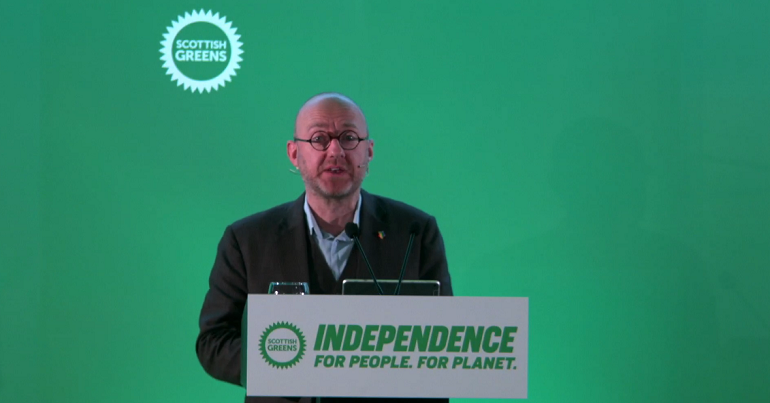Patrick Harvie to stand in Glasgow Kelvin in 2016
The Scottish Green Party has confirmed that Patrick Harvie, co-convener of the party and an MSP for Glasgow since 2003, will be contesting the constituency of Glasgow Kelvin in 2016. He will also be first on the Green Party’s regional list for Glasgow.
The Greens have performed very strongly in Glasgow Kelvin in the past, in last year’s European Elections winning 4764 votes, to Labour’s 4799 and the SNP’s 4817—making it effectively a three-way tie.
Patrick said, ‘I am delighted to be seeking the support of voters in Kelvin constituency, as well as across Glasgow region. It’s been an honour to represent the city in the Scottish Parliament for the past twelve years and I believe the time is right to contest the constituency vote.’
He added, ‘We have a strong team in Glasgow, with four Green councillors who have made a huge impact in their communities. With that track record, we are campaigning to win Kelvin in 2016.’
Zara Kitson, second on the Green regional list for Glasgow in 2016, said that ‘due to his hard work and constructive attitude in parliament and in Glasgow, and as a leading figure during the independence referendum, Patrick has rightly earned a big reputation. I know so many people will be eager to see him elected to serve the Kelvin constituency.’
This is only the second time the Scottish Greens has ever stood a candidate in a constituency contest for Holyrood. In 2007, Martin Bartos, a councillor for Partick West and the Glasgow North Westminster candidate in 2005, 2010 and 2015, stood in Glasgow Kelvin. He came third with 12.6% of the vote.
In order to win Glasgow Kelvin, Patrick and his campaign will need to mobilise a grassroots campaign on a massive scale, but a victory would represent a incredible step forward for the Scottish Greens. The party would be able to establish its first local base of support and present itself as a major player in the Scottish elections.
Combined with a strong showing for the Scottish Greens in the regional lists that could see the Greens winning around 10% of the regional vote, as polls suggest—indicating the Greens would win 8-12 MSPs, with at least one in each of the eight regions—2016 could mark the year the Greens make a political breakthrough in Scottish politics not yet seen anywhere else in the UK.
You can watch Patrick’s campaign video here:





Allan,
I know what you mean – in 2007 we got a seat for 5.2% in the north east because constituencies split between three parties in that region in that year, while we got nothing for 5.6% in the west because Labour won all constitunecies.
What I was more thinking off though is that if the Nats sweep the constituencies in 2016 as they did this year, the they would need about 55% or more in the list vote to gain any additional seats. That is doable – see north east in 2011 – but unlikely in other regions. So ‘2nd vote Green’ could (again) be a powerful slogan…
What’s the point of that?
Even if Patrick wins, this will not deliver a single extra Green MSPs.
It does though reduce the appeal for tactical voting, as it makes potential outcomes much more difficult to calculate. I don’t think is necessarily a bad thing, good electoral systems shouldn’t give scope for tactical voting as the Scottish system does, but from a purely party political point of view one has to conclude that standing constituency candidates is likely to reduce the number of Green MSPs in the next parliament.
It could actually affect the number of seats we win, if we do win Kelvin. One of the peculiarities of AMS is “overhang”, where a party wins more constituency seats than it should have won in the entire region if done purely proportionally. This means that parties that might have expected to win some constituencies actually have to get seats on the list, which in turn badly squeezes parties like the Greens that rely solely on lists.
it is more than likely, given the recent WM results that the SNP will win every seat in Glasgow. Using this year as a guide (allowing for some slippage for SNP and Labour since it is PR and people can vote Green knowing we are viable) reasonable vote shares to predict for the other parties may be;
SNP – 50%
Labour – 30%
Tories – 5.9%
Lib Dems – 2%
if the SNP win every constituency in Glasgow with that kind of regional result, Greens will need 12% to win 2 seats in Glasgow. If, instead, Patrick wins Kelvin, we’ll only need 11.2%. 0.8% may not seem a lot, but tell that to Highlands and Islands where we missed out by only 0.1 or 0.2% in 2011.
This isn’t a nationwide or even citywide strategy to stand in constituencies – we’re standing in Kelvin because we could just about win there, and if we do, it does have an effect on how many seats we may win, if we find ourselves in that kind of close run contest.
Obviously we can’t predict the exact results, but that wee example does show the kind of effect overhangs can have. This would be a less popular outcome (and one I don’t see happening), but if we somehow “split the vote” and let Labour in the constituency, that reduces the SNPs overhang too, and makes roughly the same difference to our vote share required to win tht second seat. So to write this off as pointless is slightly naive with regards to the maths of AMS.